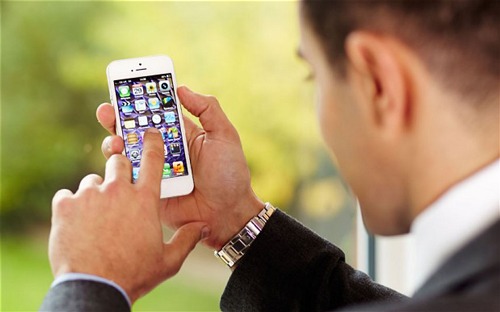For our Partner Blog Series we like to highlight the relationships we have with our peers and business partners from across all areas of the telecommunications industry. We know that when it comes to relationships, the whole really is greater than the sum of the parts. That’s why we want to share with you the wisdom, experience, and perspective of the companies we work with.
For this edition of the Partner Blog Series, we’ve called on Fueled, the groundbreaking app developers with offices in New York City, Chicago, and London. Today, we hear from Micheal Kordvani, a lifelong technology lover and Computer Sciences graduate of Queens College, as he examines the impact of an emerging technology on the future of telecommunications apps.
 The web is packed with humorous memes about poor connectivity. People don’t like wasting time and money on cut-off video connections and half-finished conversations. Telecommunication companies deliberately work on making the internet safer and faster or on new technologies that could solve the frustrating problem of speed, safety, and cost during data transfers. Unfortunately, App developers tirelessly create new telecommunication apps. While one solves team communication and it’s painfully slow, another one is super-effective for fast connectivity, but costs way more than is acceptable.
The web is packed with humorous memes about poor connectivity. People don’t like wasting time and money on cut-off video connections and half-finished conversations. Telecommunication companies deliberately work on making the internet safer and faster or on new technologies that could solve the frustrating problem of speed, safety, and cost during data transfers. Unfortunately, App developers tirelessly create new telecommunication apps. While one solves team communication and it’s painfully slow, another one is super-effective for fast connectivity, but costs way more than is acceptable.
It’s not easy to meet all criteria at once. The intriguing Li-Fi (short of Light Fidelity) is opening new doors. It’s still young, but a number of supporters are working to make it a viable solution for solving some of the current data transfer problems.
In a way similar to Wi-Fi, Li-Fi is a wireless data transfer option. However, as it uses VLC (visible light communication), Ultraviolet and Infrared waves instead of radio frequencies, it provides a variety of ways to deal with the notoriously insecure Wi-Fi connections. If you’ve by now thought that Li-Fi creates new problems while solving old ones, you’re partially true. Consequently, it may not be the perfect all-in-one solution for improving communication, but it definitely carries a lot of potentials for mobile developers to play with it’s developing functions for telecommunication apps.
Overcoming Wi-Fi Shortcomings with Li-Fi
While Wi-Fi is predominantly operational within a full building when you need to transfer data with light, walls do create a problem. On the other hand, as Li-Fi offers much bigger bandwidth, efficiency and security, it solves radio interference issues for a low cost. The world of data communication is jam-packed and with smart connectivity, the volume is only getting bigger. We all know the frustration of slow Wi-Fi when multiple devices are connected to a network. The number of connected devices grows by billions. Despite Wi-Fi’s current optimal performance for confined spaces, the fixed bandwidth makes high data transfer a problem. Since Li-Fi works well with LED and lighting units, there are plenty of options for developing the medium. At least one area where Li-Fi has exciting possibilities is smart automation. In this sense, telecommunication app developers can start thinking well out of the extent of Slack, Skype, Zoom or other mobile apps that are now solving business communication problems.
Li-Fi supported devices which are based on a larger part of the electromagnetic spectrum provide endless possibilities for data transfer by light in smart homes. This doesn’t mean that we will get rid of the communication over the internet as it is now. Maybe we won’t leave Ethernet cables or Wi-fi routers to the history yet, but this new telecommunication technology can change the way we stream videos, send emails or access the web.
Majority of standard office operations in the foreseeable future could be managed via a Li-fi based telecommunication app. Your smartphone will be the tool to turn on the LED lights, set the room temperature, organize clock alarms, arrange an HD video streaming calendar or print your meeting agenda. And yes – hold a meeting on a plane! Cost and security work extremely well with Li-Fi.
The extensive growth in the use of LEDs for illumination provides a rich opportunity for integration of the technology. If we consider the shortcomings of Li-Fi, such as the necessity of an immediate access to a light source, the short-range reach of Li-Fi and the limitations posed by natural sunlight or physical obstacles, as well as the high costs of mass-scale adoption, it’s still early age to predict the full application. At the same time, it’s a fertile moment to test its potential for inventive telecommunication apps that can make our lives easier at smart homes and automated offices.
Future Areas for Development of Li-Fi Telecommunication Apps
What are the areas for developing profitable software products that can solve more problems than creating ones? Future applications of the Li-Fi technology could make educational institutions work better due to faster internet. When Wi-Fi is backed up by Li-Fi, medical equipment that suffers from Wi-Fi interferences can be made much safer. Although Li-Fi is not without its own drawbacks in terms of penetrating dense environments (for example, underwater), when Wi-Fi fails, light data transfers can take over to support underwater exploration.
For sensitive industries, such as energy providers (power plants), Li-Fi is a safe connectivity solution that can be easily monitored. Where other less secure technologies – Bluetooth or NFC are forbidden, Li-Fi short-range networks are a viable replacement solution. In the end, the technology can offer effective connectivity for smartphones or laptops on-the-go, or strengthen the safety of traffic via car LED lights.
Areas with ample LED light are Li-Fi friendly and, no doubt, carry a vast creative capacity for testing telecommunication apps that bring all these technologies together. When the technology becomes commercially successful, cleaner environments and improved health are irreplaceable benefits to be gained. The impetus is on. It’s up to developers to find ways and turn researchers’ results into business products.
So what do you think? Will Li-Fi be the technology of the future and become as familiar, ubiquitous, and necessary as Wi-Fi? You can let us know what you think on Twitter and Facebook, and be sure to give a shout out to Fueled while you’re at it for this thorough review. Also, no matter what core technology your business network operates over, if you ever have any challenges now or in the future, you can garantee our VirtualPBX Customer Support will be there to help you through it!






